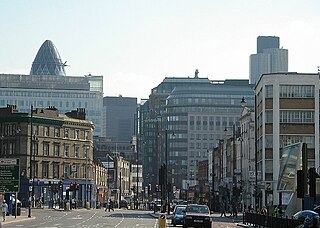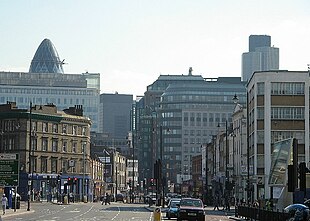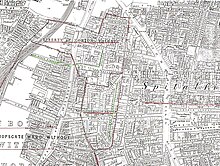
Bethnal Green is an area in London, England and is located in the London Borough of Tower Hamlets. It is in east London and part of the East End. The area emerged from the small settlement which developed around the Green, much of which survives today as Bethnal Green Gardens, beside Cambridge Heath Road. By the 16th century the term applied to a wider rural area, the Hamlet of Bethnal Green, which subsequently became a Parish, then a Metropolitan Borough before merging with neighbouring areas to become the north-western part of the new Tower Hamlets.

Shoreditch is an area in London, England and is located in the London Borough of Hackney alongside neighbouring parts of Tower Hamlets, which are also perceived as part of the area due to historic ecclesiastical links. Shoreditch lies just north-east of the border with the City of London and is considered to be a part of London's East End.

Stepney is an area in London, England and is located in the London Borough of Tower Hamlets. It is in East London and part of the East End. Stepney is no longer officially defined, and is usually used to refer to a relatively small area. However, for much of its history the place name applied to a much larger manor and parish. Stepney Green is a remnant of a larger area of Common Land formerly known as Mile End Green.

The London Borough of Tower Hamlets is a borough of London, England. Situated on the north bank of the River Thames and immediately east of the City of London, the borough spans much of the traditional East End of London and includes much of the regenerated London Docklands area. The 2019 mid-year population for the borough is estimated at 324,745.

Commercial Street is an arterial road in Tower Hamlets, east London that runs north to south from Shoreditch High Street to Whitechapel High Street through the East End district of Spitalfields. The road is a section of the A1202 London Inner Ring Road and as such forms part of the boundary of the London congestion charge zone.

Bromley, commonly known as Bromley-by-Bow, is a district in the London Borough of Tower Hamlets in East London, located on the western banks of the River Lea, in the Lower Lea Valley in East London.

Bishopsgate was one of the eastern gates in London's former defensive wall. The gate's name is traditionally attributed to Earconwald, who was Bishop of London in the 7th century. It was first built in Roman times and marked the beginning of Ermine Street, the ancient road running from London to York (Eboracum). The gate was rebuilt twice in the 15th and 18th centuries, but was permanently demolished in 1760.

Spitalfields is an area in London, England and is located in the London Borough of Tower Hamlets. It is in East London and situated in the East End. Spitalfields is formed around Commercial Street and Brick Lane. It has several markets, including Spitalfields Market, the historic Old Spitalfields Market, Brick Lane Market and Petticoat Lane Market. The area has a long attracted migrants from overseas, including many Jews, whose presence gained the area the 19th century nickname of Little Jerusalem.

Bethnal Green was a civil parish and a metropolitan borough of the County of London between 1899 and 1965, when it was merged with the Metropolitan Borough of Stepney and the Metropolitan Borough of Poplar to form the London Borough of Tower Hamlets.

The Metropolitan Borough of Stepney was a Metropolitan borough in the County of London created in 1900. In 1965 it became part of the London Borough of Tower Hamlets.

The Metropolitan Borough of Shoreditch was a metropolitan borough of the County of London between 1899 and 1965, when it was merged with the Metropolitan Borough of Stoke Newington and the Metropolitan Borough of Hackney to form the London Borough of Hackney.

Brick Lane is a famous street in the East End of London, in the borough of Tower Hamlets. It runs from Swanfield Street in Bethnal Green in the north, crosses the Bethnal Green Road before reaching the busiest, most commercially active part which runs through Spitalfields, or along its eastern edge. Brick Lane's southern end is connected to Whitechapel High Street by a short extension called Osborn Street.

Norton Folgate is a short length of street in London, connecting Bishopsgate with Shoreditch High Street, on the northern edge of the City of London.

The Tower Division was a liberty in the ancient county of Middlesex, England. It was also known as the Tower Hamlets, and took its name from the military obligations owed to the Constable of the Tower of London. The term ‘Hamlets’ probably referred to territorial sub-divisions of the parish of Stepney – and its daughter parishes – rather than to the usual meaning of a small village.

The Old Artillery Ground is an area of land in Spitalfields, London formerly designated one of the Liberties of the Tower of London and Crown Land.

Tower Hamlets was a parliamentary borough (constituency) in Middlesex, England from 1832 to 1885. It elected two Members of Parliament (MPs) to the House of Commons of the Parliament of the United Kingdom. It was one of the first five of its type in the metropolitan area of London. It was enfranchised by the Reform Act 1832.

Bishopsgate (Low Level) was a railway station opened by the Great Eastern Railway (GER) on 4 November 1872 alongside the company's first London terminus, Bishopsgate, which stood on a viaduct (and thus became also known as Bishopsgate (High Level)). The newer station was on a lower route, leading south-west, which the GER was building to its future Liverpool Street terminus and was situated on Quaker Street, on the eastern side of Shoreditch High Street (now in the London Borough of Tower Hamlets but then in the Metropolitan Borough of Bethnal Green) near Bishopsgate.

The East End of London, often referred to within the London area simply as the East End, is the historic core of wider East London, east of the Roman and medieval walls of the City of London and north of the River Thames. It does not have universally accepted boundaries on its north and east sides, though the River Lea is sometimes seen as the eastern boundary. Parts of it may be regarded as lying within Central London. The term "East of Aldgate Pump" is sometimes used as a synonym for the area.

Mile End New Town is a former hamlet and then civil parish in the East End of London. Its former area is now part of the London Borough of Tower Hamlets.

Whitechapel was a local government district within the metropolitan area of London, England from 1855 to 1900.






















